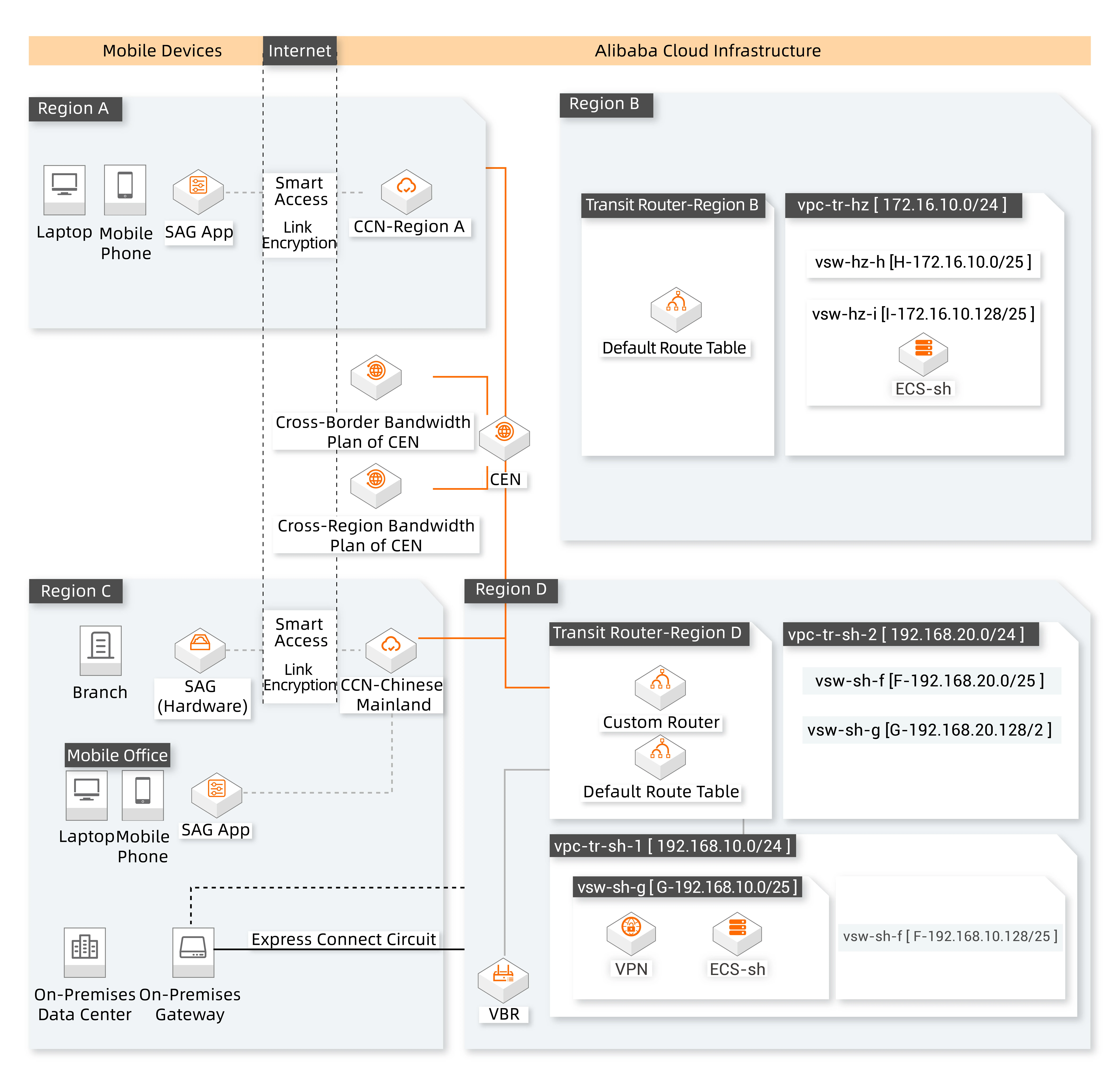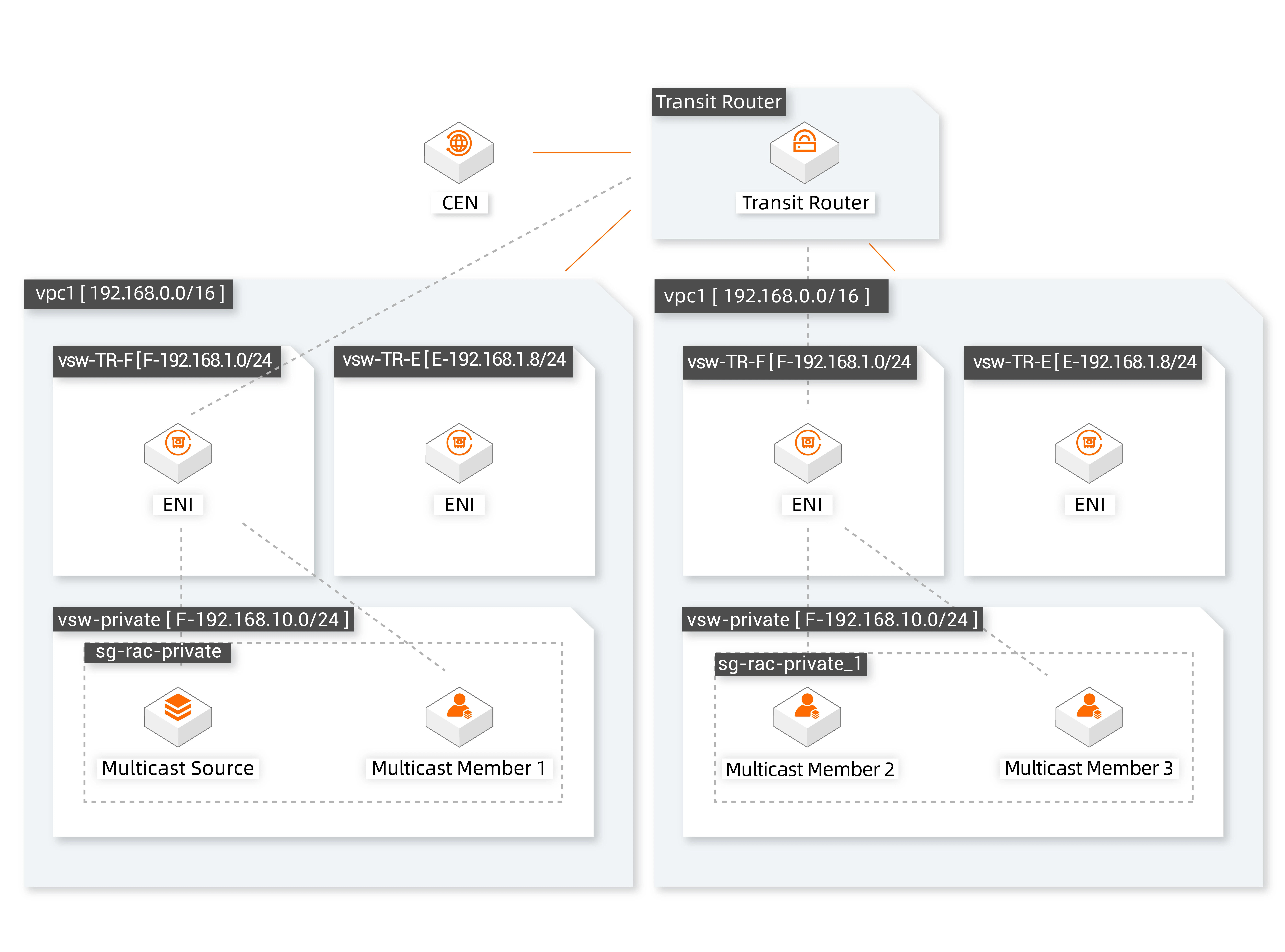
A transit router functions as a core router for the region where the transit router is deployed. Transit routers help users quickly build enterprise-class networks that support high scalability. Simplified networking between on-premises and cloud resources helps users efficiently build networks in cloud migration, hybrid cloud, and multi-cloud scenarios.
● Forward network traffic within a region, across regions, and between on-premises and cloud resources.
● Supports VPCs, VPN gateways, SD-WANs, and Express Connect circuits.
● Supports on-demand networking, isolation, and rerouting within a region.
Features
Centralized Connections
A transit router functions as a core router for the region where the transit router is deployed and supports attachments of various types of network instances.
Connect to a Large Number of VPCs
VPCs in the same region can connect to the same transit router to communicate with each other. Each transit router supports up to 1,000 VPCs.
Connect to On-Premises Networks over VPN Gateways
On-premises networks can connect to transit routers over VPN gateways to establish network communication with cloud resources. VPN attachments support EMCP routing that provides a higher bandwidth capacity.
Connect to On-Premises Network over Express Connect Circuits
VBRs can be connected to transit routers to connect data centers to Alibaba Cloud over Express Connect circuits.
Connect to On-Premises Networks over 3rd Party SD-WAN Appliances
Transit routers can be connected to SD-WANs of Fortinet, Cisco Meraki, Palo Alto, and Aruba. You can purchase on Alibaba Cloud Marketplace and perform a quick deployment to connect your on-premises network to Alibaba Cloud.
Connect to Other Transit Routers
Transit routers attached to the same CEN instance can communicate with each other, helping users build an exclusive network on a global scale.
Flexible Route Management
Transit routers support flexible route management that allows enterprises to connect and isolate networks in a complex topology.
Multiple Route Tables
Each transit router supports multiple route tables, which can be associated with different network instances to isolate and reroute network traffic in a complex topology.
Automatic Route Learning
Each transit router supports multiple route tables, which can be associated with different network instances to isolate and reroute network traffic in a complex topology.
Associate with Prefix Lists
After a transit router is associated with a prefix list, routes that point to the CIDR blocks in the prefix list are automatically added to the route table of the transit router. This simplifies route configurations.
Fine-Grained Bandwidth Management
Fine-grained analytics and management of bandwidth for inter-region communication and hybrid cloud scenarios.
Guaranteed Bandwidth for Inter-Region Communication
You can create multiple QoS queues for the inter-region connection between transit routers in two different regions. The queues are isolated from each other and process requests destined for different services. This prevents bandwidth competition between services.
Flow Logs for Inter-Region Communication
Flow logs can be used to capture information about network traffic between transit routers. You can analyze bandwidth usage, troubleshoot network errors, and make a better budget for data transfers based on the captured information.
Cloud-Native Multicast
Transit routers can replicate and distribute multicast packets within a region or across regions.
Custom Multicast Sources and Members
Fine-grained control over the transmitters and receivers of multicast packets.
TR Benefits
Large-Scale Communication
Connect to up to 1,000 VPCs and on-premises networks to help enterprises expand their businesses.
Flexible Scheduling
Support on-demand rerouting based on multiple custom route tables to help enterprises build networks in a complex topology.
Cloud-Native Multicast
Support replication and forwarding of multicast packets to help enterprises migrate applications using multicast (such as financial and media applications).
High Reliability
A high-performance NFV platform that supports intra-zone and inter-zone disaster recovery to ensure service availability.
TR Scenarios

Requirements
As more enterprises migrate their services to the cloud, systems of different enterprise entities, departments, and projects are deployed in different VPCs and managed by different accounts due to financial, compliance, risk control, and business dependency requirements. These systems may also need to communicate with each other across regions and VPCs or with on-premises networks. Critical and noncritical services, private and public services, and internal and Internet services are rated at different security levels. The network traffic between these services needs to be regulated and audited.
Benefits
-
 Build Networks on a Global Scale
Build Networks on a Global ScaleBuild enterprise-class network architectures on the cloud, isolate VPCs, and connect VPCs to transit routers to enable inter-region communication, isolation, and rerouting based on route tables.
-
 Centralized Control over Network Traffic between Services with Different Security Requirements
Centralized Control over Network Traffic between Services with Different Security RequirementsEnable service chaining based on multiple route tables, establish network communication between VPCs, and regulate and audit network traffic by rerouting network traffic to the access control VPC.
Works Best With

Requirements
When services that require multicast (such as financial information services, livestreaming services, Oracle RAC databases, and publish-subscribe messaging services) are migrated to the cloud, they need cloud-native multicast services to replicate and forward multicast packets.
Benefits
-
 Smooth Migration to the Cloud
Smooth Migration to the CloudMulticast applications can be deployed on the cloud without modifications.
-
 High Scalability and High Availability
High Scalability and High AvailabilityMulticast bandwidth resources and high availability are ready to use. Transit routers can be deployed in multiple zones and automatically scaled based on traffic volumes.




